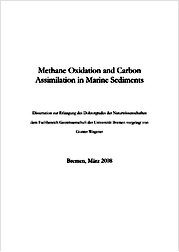| dc.description.abstract | Anaerobe Oxidation of Methane, AOM, methanotrophy, stable isotope labeling, stable isotope probing, carbon assimilation, flow-through columns, ANME, Seep-SRB, Gullfaks, Tommeliten. - Anaerobic oxidation of methane (AOM) performed by consortia of methanotrophic archaea (ANME) and sulfate reducing bacteria (SRB) is the major sink of methane in marine sediments. This thesis describes methane consumption at two of the most active North Sea cold seeps (Gullfaks, Tommeliten), their microbial community and the resulting lipid biomarker patterns. Experiments in flow-through setups are presented, focusing on physiological parameters of AOM activity such as different methane and sulfate concentrations and on the tolerance of AOM to starvation periods. The roles of inorganic carbon (DIC) and methane as carbon sources for the microbial community performing AOM were examined combining stable isotope probing and lipid biomarker analyses. For archaea substantial uptake of carbon from DIC and methane was found, indicting a novel carbon assimilation pathway. Biomass from SRB was exclusively labeled by DIC indicating a methane dependent, but autotrophic growth consortial SRB. | |


